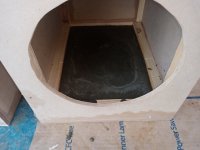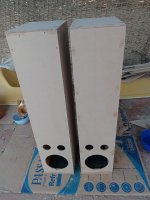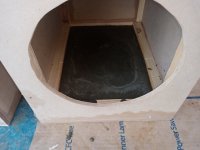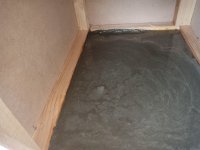There is plenty. A quick google of 'Acoustic properties of Concrete' will save regurgitating it here.Any data to back this up?
Surface texture and porosity affect absorption dramatically - the absorption of block walls is greatly reduced by a thin skim of plaster, and painting the surface reduces it further.
When the measured reverberation time of our test chambers started to shorten we knew it was time to jetwash all the smooth concrete surfaces, as even absorption by dust was measurable!
Last edited:
Good point... for DIY one-off, wood-based sheet stock is hard to beat... but for low volume manufacturing, molding/casting starts to make a lot of sense.It would look cool! Also I could imagine an economic benefit to a small-volume manufacturer when the cabinet could be poured in one piece and little or no finishing required. Compare that to the time it takes to build a cabinet and finish it with wood. I've actually been thinking about trying this lately and see how it compares to the other cabinet materials I've been measuring.
The concrete enclosure concept reminds me of these new composite granite countertops, which are very cool. If you could take this type of material and cast it into a mold of sorts, the end product would look highly refined and likely perform very well acoustically (as well as asthetically) as an enclosure.
IIRC Audio physics had speakers like this but made from natural slabs of machined granite, which is very expensive and isn't that suitable in its raw form to be used as an enclosure without another type of surface treatment, mainly because it rings like a bell. Using a composite for this makes so much sense.
IIRC Audio physics had speakers like this but made from natural slabs of machined granite, which is very expensive and isn't that suitable in its raw form to be used as an enclosure without another type of surface treatment, mainly because it rings like a bell. Using a composite for this makes so much sense.
View attachment 1129344"The standard speaker cabinet material is wood-based sheet goods (MDF, plywood, etc). It works really well, its easy to construct with, and it is not expensive. Any other material will need to be compared to this.
In order for me to consider GFRC for cabinets, I would need to understand what problem or unmet need is this material going to address? in other words, I would have to identify a deficiency in wood-based sheet materials, and then understand how GFRC addresses that deficiency. I would also need to think about those aspects in which GFRC is inferior to wood-based sheet materials, so I could understand what performance aspect I am gaining, and what I am losing.
At this point, I can't think of any serious deficiency with wood-based sheet materials. So to the proponents of GFRC, can you identify what the advantages would be ?"
j.
If you zoom in a bit on these imagine replicating this in MDF. The countersink for a truncated frame woofer would be difficult to achieve with a router setup. The sharp recessed edge of the truncated flat where it meets the arc would not be possible since it would be limited to the radius of the router bit . Most truncated frames are meant to be surface mounted, but that is really a compromise for ease of application among a wide range of diy'ers with limited tools. Most, I would think, would prefer to have the woofer as flush and seamless as possible. And the piece (negative) that is inserted into the mold to produce this countersink is very simply cut with a jigsaw. The cutout above is modelled on a Peerless 6.5 in 830874. The large(ish) radius edge roundovers would be another very difficult task for most of us lacking a router bit this size. In the case of a mold you are only limited by the corner molding you can find at your home depot. To be able to integrate a wave guide into your one piece, seamless, baffle simply by inserting a plaster cast negative of any waveguide available to you is just one more aspect I find pretty appealing.
The mention of resonance in the baffle/cabinet is often an interesting one. Again, the disclaimer that I lack any advanced knowlege of these fundamentals. But I recall a question posed here years ago about the prospect of designing the cabinet with some appreciation to the fact that bodies of many stringed instruments are purposefully resonant. Why not take advantage of this when designing a loudspeaker? The consensus, of course, is that sympathetic resonance in a loudspeaker cabinet, following the primary resonance of the drivers, is absolutely to be avoided. Disregarding surface reflectivity, as some of the posts here have addressed, I can only intuit that a heavy large mass integral to the body of a loudspeaker would in almost any case be beneficial. Similar to the idea of a solid dense and heavy base on a turntable. If the goal is to either eliminate resonance and/or push the boundaries of resonance beyond the range of hearing it seems like such a resonance 'sink' as a mass of concrete would be near to optimal. But again, I'm no scientist by a loooong shot.
The reason why I dismissed surface reflectivity is because it's not unique to a concrete baffle when compared to any other. These discussions generally tend toward faceting, contours, edge diffrations, counter sinking, etc. Commentary on this, or of such as foam or felt surface treatments on baffles or felt lenses on tweeters or various other mention of surface reflectivity applies equally to concrete as to wood itself or even to the surfaces of commercial waveguides.
The difference in cost, compared to MDF, is negligible for the sake of DIY. Production would be another matter, but we're talking perhaps a very rough guess of 20 to 30 more dollars for an average speaker pair using concrete. With current lumber prices, probably less.
It turns out that companies offer redimix bags of 'self consolidating' GFRC for simple projects without the need for surface prespraying/coating. Trinic has a lot of info at their website. I emailed them with a link to this thread.
Last edited:
"...sympathetic resonance in a loudspeaker cabinet, following the primary energy of the drivers,..."
Is that better put?
And I'm interested in knowing more about the idea of cancellations, or near cancellations, that are provided by mass such as a block of concrete. If part of the appeal of cast frame drivers is in rigidly linking the cone and suspension to the magnet and cabinet, with as little resonance as possible, wouldn't mounting that speaker frame to a mass of concrete merely be extending any advantages gained by such rigidity?
Is that better put?
And I'm interested in knowing more about the idea of cancellations, or near cancellations, that are provided by mass such as a block of concrete. If part of the appeal of cast frame drivers is in rigidly linking the cone and suspension to the magnet and cabinet, with as little resonance as possible, wouldn't mounting that speaker frame to a mass of concrete merely be extending any advantages gained by such rigidity?
Last edited:
Use the GFRC mix only with N95 mask AND breathing apparatus.
If it is ready mix, it will have fine glass particles, carcinogenic.
The composite marble counters were marble pebbles and finer mixed into acrylic monomer, and cast into sheets (tops).
The granite counter tops will be similar, and will be easy to experiment with, if available in sheets.
The concrete forms can be cast using techniques used in casting iron using patterns, and shells.
If it is ready mix, it will have fine glass particles, carcinogenic.
The composite marble counters were marble pebbles and finer mixed into acrylic monomer, and cast into sheets (tops).
The granite counter tops will be similar, and will be easy to experiment with, if available in sheets.
The concrete forms can be cast using techniques used in casting iron using patterns, and shells.
I use only thin mdf or wood for boxes and put on all sides concrete into it like 1cm. This makes an enclosure with good acoustic properties.
Attachments
- Home
- Loudspeakers
- Multi-Way
- Anyone toyed with the idea of GFRC glass-fiber-reinforced-concrete for baffles?



